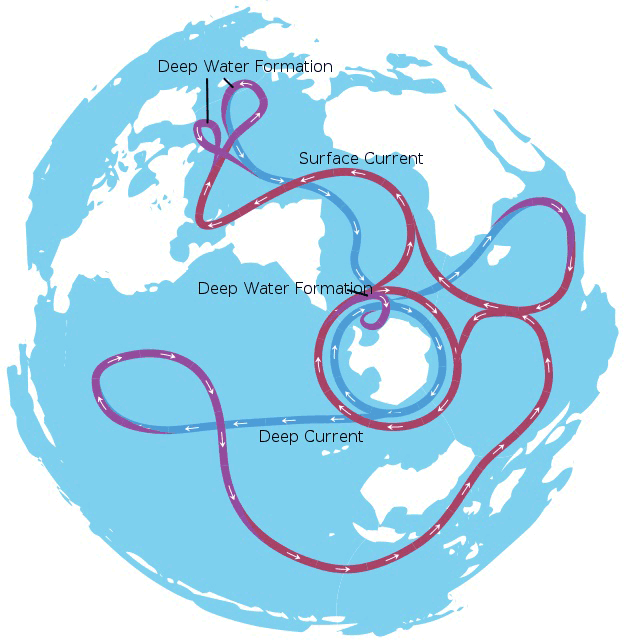Our Environment, Animal Tips & the Great Outdoors

Vital Ocean Current Projected to Collapse in the Near Future
In case you weren’t worried about the climate yet today, here’s a reason for you to be.
The Atlantic Meridional Overturning Circulation – AMOC for short – is projected to collapse in the near future, meaning any time between 2025 and 2095.
Why is this important? The AMOC is a very important ocean current – that is part of the global ocean conveyor belt – and is responsible for transporting warm saltwater from the tropics up to the North Atlantic. In layman’s terms, the AMOC is responsible for keeping temperatures moderate across North and South America, as well as in Europe.
AMOC functions like a conveyor belt – so it transports warm water from the tropics northward and circulates cold water southward along the ocean floor, effectively keeping the temperatures across the globe relatively stable. However, with warming globe temperatures caused by carbon emissions, the danger of AMOC collapsing is coming closer and closer, which needless to say, would be devastating for the global climate.
AMOC is also vital to supporting ocean life through its moderation of the water temperature. The current’s movement has been slowing over the past 150 years, and a recent study published by the journal Nature shares that there is a high-confidence that the ocean current will tip by mid-century, or between 2025 and 2095. This means that if the global temperatures continue to rise as they have been, the current could reach a tipping point that causes it to stop moving completely, and later, to collapse.
A collapse of AMOC would have huge implications for the climate in a relatively short period of time. According to the Weather Channel, some of these implications could include a 30 degree temperature drop in Europe, dramatic droughts, and sea level rise in the United States as well as stronger hurricanes along the East Coast.
Dr. Zion Klos, who has a doctorate in Hydrology and is a Professor of Environmental Science at Marist College in Poughkeepsie, NY, reiterates the importance of the AMOC in keeping temperatures stable in the North Atlantic Ocean. He says that a collapse could create a “rapid drop in annual temperatures” in regions in the northern parts, such as the countries in Scandinavia like Iceland and Norway, countries in Great Britain like Ireland, as well as other western European countries. “Similarly, with the lack of warm water moving northward away from the tropics, then the tropics would see rapid rises in temperature.”

Dr. Beate Liepert, a Visiting Professor of Physics and Environmental Studies and Co-Director of the Center for Environmental Science and Humanities at Bard College in Annandale-on-Hudson, NY, concurs with much of what Dr. Klos says. She states that North America would expect a cooler climate with more storm surges, while Europe would be drier.
“The difference is that over the last decades the planet is not warming because we’re coming out of an ice age, we are warming the planet because we are burning fossil fuels,” Dr. Liepert says.
Theresa Morris, an Adjunct Professor in the Philosophy Department at Marist College who also teaches Environmental Ethics, agrees with both Dr. Klos and Dr. Lipert says that it is “likely that the collapse of ocean currents will accelerate climate trends such as sea level rise, and changes in temperature and weather here in the Hudson Valley.” Professor Morris also mentions that the Hudson River is connected to the Atlantic Ocean, which means that any changes in sea level will be reflected in this area as well.
Dr. Klos says that the changes in temperature in ocean water could rapidly change the marine habitat that we depend on for fish, lobster, crab, and shellfish, among others along the East Coast. Here in the Hudson Valley, sea level rise could cause more salt water to push its way into the Hudson River, which would not only threaten the freshwater marine life, but would also potentially pose an issue for the towns and cities that get their drinking water from the Hudson River.
“We would need to rapidly reduce the amount of greenhouse gasses in the atmosphere to have any hope of preventing this,” says Dr. Klos. “We would need to get countries to agree to these reductions at a global scale.”
Professor Morris says that, as a gardener, she has personally experienced the ever-changing climate in the Hudson Valley. “There is more rainfall overall and at times, too much rainfall in a day or week,” she says. “Getting a month’s rainfall in one day causes flooding and can wash out soil and drown crops. There may be a month with no rain. These kinds of erratic weather patterns threaten farmers’ ability to grow crops. Obviously, this has troubling implications for all of us, as we depend on a stable environment for all our needs.” (Main Street Magazine has been actively covering the ways in which the excessive rainfall this season has been affecting farms in our area – read more here.)
Dr. Klos does say that an ocean current has collapsed like this before, but that it can “take thousands of years to recover.” He also says that this change has happened “multiple times in just the past 70,000 years as the globe warmed and cooled during previous glacial periods.” Based on the geologic record, Dr. Klos says that we can tell that these current changes and collapses had “major implications for global temperature and for marine ecosystems.”
Professor Morris says that, “as an ethicist, my interest in the human response to what we know about the causes of climate change. How can we take responsibility for such a large-scale phenomenon? We need to first recognize what is happening, try to understand the causes, see how our everyday lifestyles contribute to the problem, and then work together to do everything we can to prevent further damage to our atmosphere.”



